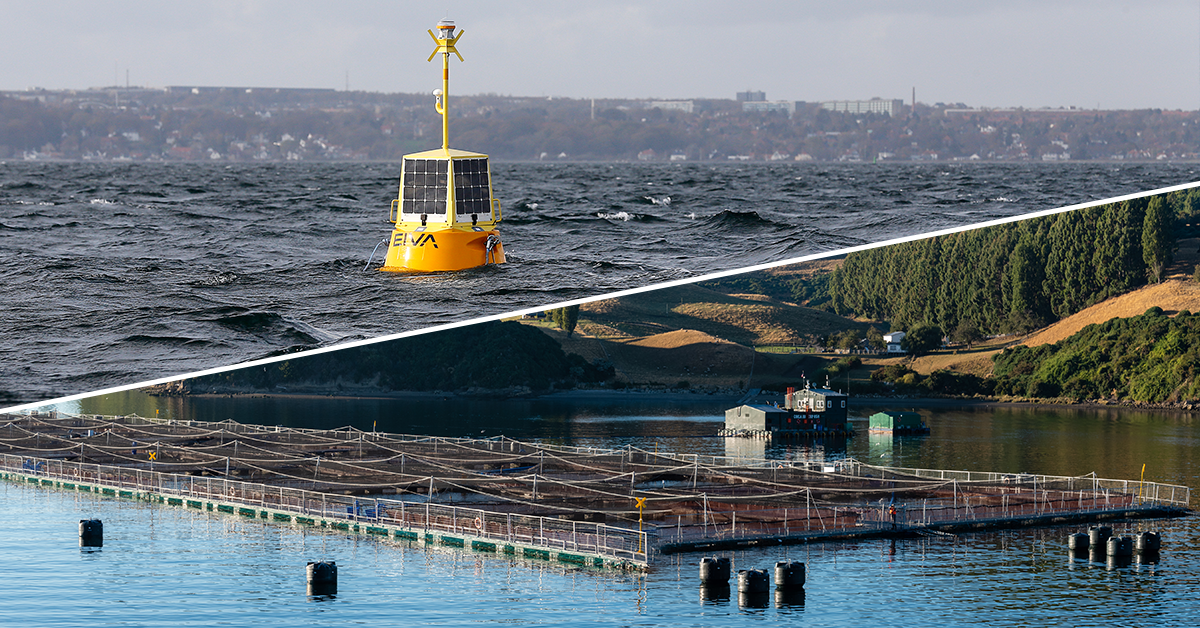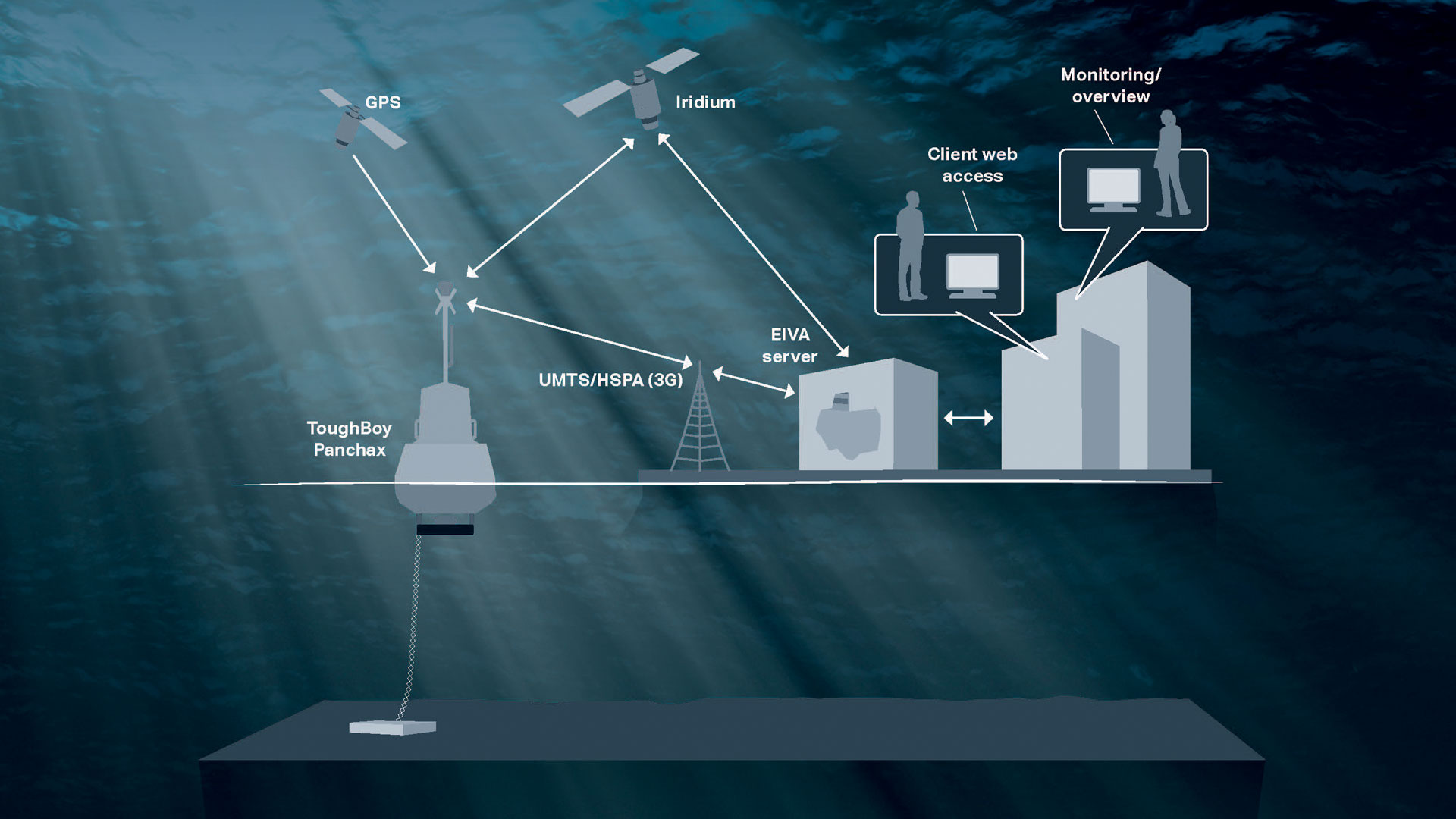
To use this site, please enable javascript

To use this site, please enable javascript
The ToughBoy, EIVA’s robust, remote data collection buoy provides a platform for sensors which can be used to help aquatic farm operators collect reliable, real-time data which you can consider when planning feeding and work decisions – so your decisions are optimised and sustainable. By providing insights into factors affecting marine environments, this system can help aquaculture facilities to comply with environmental regulations and protect the marine environments that sustain them.
To ensure a sustainable future for ecosystems and the aquaculture industry, data collection systems like this are vital. Recently, in Chile, a law was passed requiring aquaculture facilities, specifically salmon farms, to control the amount of deposit on the seabed (inorganic and organic). By taking actions like this to prevent harmful algal blooms (HAB), the goal is to prevent the devastating environmental and economic consequences they bring – however, the factors leading to HABs have yet to be studied scientifically, which is one of the reasons data collection is needed to ensure the right actions are being taken.
In this article, you will dive into a new system for aquaculture data monitoring: the ToughBoy data buoy equipped with a variety of possible in situ sensors. Read on to learn about…
The sensor setup described below is developed together with Chelsea Technologies, EIVA’s sister company in the Covelya Group, among others providing expertise in aquaculture.

The ToughBoy data buoy (shown above) can collect data to help make decisions for aquaculture facilities, such as fish farms (bottom image courtesy of Gordon Leggett / Wikimedia Commons)
Marine sensor data helps aquatic farmers optimise their decisions. For some recognisable examples, you’ve maybe needed to consider if the waves are high, to decide whether it’s a good time to sail out to work on the pens. Likewise, if the current is strong, you know not to add feed to the water which will drift away and become pollution. These are only two of many possible factors to monitor and consider. By studying various trends over a longer time, marine data can also help with decisions such as where to build aquatic farms so they will have the smallest impact on the environment and reduce fish waste pollution.
Let’s dive into the various oceanographic, weather and environmental sensors used on the ToughBoy to obtain these data. We’ll go through them by location on the data buoy, sailing through the different neighbourhoods they live in – above or below the water’s surface.
On the floating, moored buoy of the ToughBoy platform, you can equip metocean sensors such as:
On the other end, sensors can be mounted to the seabed with a bottom frame – such as ADCPs for superior current measurements. EIVA’s Sentinel V ADCP bottom frame is made of stainless steel and protected with zinc anodes against galvanic corrosion. Via a cable, the bottom-mounted ADCP is connected to the ToughBoy, where sensor data is stored and transferred to the web portal, ToughBoy Onshore, together with all other sensor data from the buoy (later in this article, we will dive into how data is displayed).

A possible aquaculture setup with the ToughBoy data buoy
In the water below the ToughBoy data buoy, environmental sensors can be placed at customisable levels in subsea pods attached to cables along the mooring (as shown above). These can be sensors measuring conductivity, temperature, oxygen, pressure and pH – and any other environmental factors you take into consideration, whether you’re farming fish, mussels or seaweed, due to their impact on the resources of the aquatic farm and the conditions of the water body around it.
Studying algal levels is vital, since HABs have devastating consequences to the marine ecosystems which sustain aquatic farms.
Chelsea Technologies produces highly sensitive fluorometers for monitoring several key algal parameters. For integration with the ToughBoy, we recommend the TriLux multi-parameter algae fluorometer tomonitor algal blooms – whether in rivers, lakes, estuaries or oceans. This can be paired with the UviLux UV fluorometer for measuring tryptophan and CDOM to better understand the underlying water quality conditions.

The UviLux and TriLux fluorometers from Chelsea Technologies (above) and the ToughBoy data buoys from EIVA (below)
How easy is the sensor platform to deploy and service? These are important questions to ask when considering the cost of ownership over time. The ToughBoy data buoy ensures a low cost of ownership through robust design requiring minimal servicing. This data buoy can be deployed with just a few easily available tools and without special training. The same goes for servicing – which is infrequent thanks to low power consumption and intelligent solar powered battery charging.
Learn how EIVA designed the ToughBoy to be operational for a minimum of 12 months between battery changes even in conditions where there is less sun energy to harvest.
'Even without being a technician, we found the ToughBoy was easy to assemble and use. We pretty much didn’t have to do anything more than put it in the water.' – Ole Smith, WSP, said about his experience using the ToughBoy in a case study.

Watch this video of a ToughBoy deployment
An important factor to consider in a data buoy is the data communication setup. The ToughBoy is available with a communication unit using GSM/3G/HSDPA/GPRS and Iridium, to transmit the data collected from all the integrated sensors in real-time to you through EIVA’s web portal, ToughBoy Onshore. ToughBoy Onshore provides not only configurable data displays, but also helpful tools like real-time alerts, to reduce risks to aquaculture assets by helping you act quickly in an emergency.

Take a tour through the ToughBoy Onshore web portal to see what features you get
An AIS transmitter can also be installed to transmit the buoy’s position to nearby vessels’ navigation systems, providing extra safety for the buoy in trafficked areas.
Want to monitor another type of data? The EIVA team is happy to work on adding support for other sensors – to help meet your exact data monitoring needs. Feel free to reach out and let us know what setup you need. Our team of in-house engineers has a great deal of experience providing custom hardware and software solutions.
To dive deeper into the ToughBoy’s payload possibilities, including a larger model for deploying more sensors, check out our recent article on the diverse possibilities for sensor integration on the ToughBoy:

An illustration of the ToughBoy general communication setup
Don’t forget to follow our social media and/or newsletter to stay tuned for more articles on the ToughBoy.
If you’d like these benefits to float in your project’s waters, you can dive into our webshop or reach out to learn more.